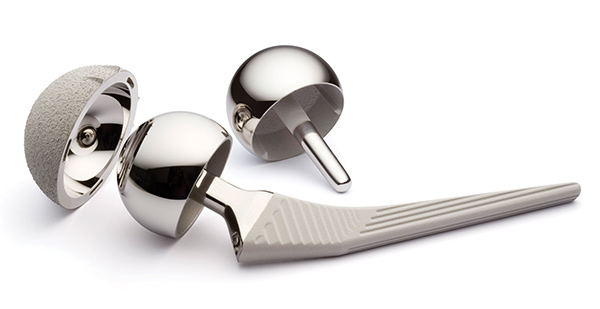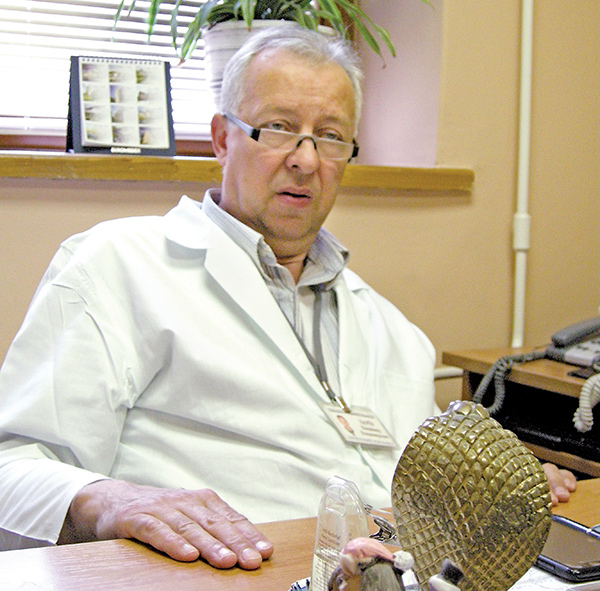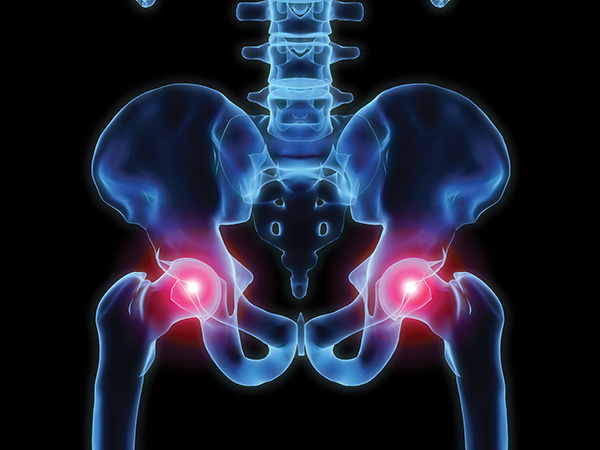New knee, hip, and ankle joints can offer sufferers a new lease of life. Over the past quarter of a century,
 there have been tens of dozens of such operations in Belarus, including some surgeries on foreigners. During four last months of 2015 alone, 175 foreigners sought medical attention at the 6th Clinical Hospital and underwent treatment there. And 27 foreigners were operated. Medical tourism in Belarus is becoming more popular, especially in orthopaedics. Here, we meet some of those who have been helping improve the lives of others for three decades.
there have been tens of dozens of such operations in Belarus, including some surgeries on foreigners. During four last months of 2015 alone, 175 foreigners sought medical attention at the 6th Clinical Hospital and underwent treatment there. And 27 foreigners were operated. Medical tourism in Belarus is becoming more popular, especially in orthopaedics. Here, we meet some of those who have been helping improve the lives of others for three decades.
Pain a thing of the past
Vladimir, the years take their toll on our bodies. What happens with our joints?
A joint has a certain job to do. Our bodies have the capacity to regenerate, with nails growing for instance. However, if you wore a thimble on your trimmed nail, it would prevent growth. Certain conditions are needed for our body to do its job. If you fracture a bone, you need to have it immobilized in order for it to heal. If the job isn’t well done, your leg will heal but with weakness: with a ‘false joint’ formed where the bone has knitted. There is scar tissue, then fibrous cartilage, and then a joint: your body realigns its processes! I underline that joints allow movement. They wear out through use, and certain sports and jobs place extra strain on them. We all age differently in this respect. Some illnesses also weaken joints, such as psoriasis and rheumatism.
Is it good to keep moving?
Yes; it helps. If patients come to us in the early stages of osteoarthritis and heed our recommendations, we can stop their joints from wearing out at the same rate.
Is a healthy lifestyle essential to maintain mobility in old age?
Of course! In addition, avoid illnesses prone to degrading your cartilage and connective tissue.
If, unfortunately, the joint needs replacing, is there an age limit?
Not at all; it’s never too late to walk again and enjoy life. However, you need to be in a reasonably fit condition. We have performed such surgery on patients aged 100 or more. There were two last year: a woman and a man. Both had suffered a medial femur neck fracture. Usually, at this age, patients aren’t fit enough to endure surgery, but these two were exceptions and left on their feet. We have great ability and can perform surgery at any age, in theory. We have a 91-year-old patient who looks 65. He is a clever man who looks after his health and listens to his body. He avoids becoming ill and has joints similarly ‘young’. He has told us that he’s aiming to live to 120.
Do you see many patients like this?
More than we used to. I admire these people. After all, it’s not easy to consistently look after your health; it takes time and effort. However, those who do, have fewer joint problems. If they do suffer, it tends to be a congenital disorder. Preventive medicine can deter the severity of such diseases, if caught early, so never delay seeing your doctor. Prompt diagnosis of early hip dislocation or dysplasia of the hip joint may allow correction without surgery.

Better before…
At what age can child dysplasia be corrected without surgery?
The sooner changes are detected, the better. As a rule, such newborn problems tend to be hip joint related. The orthopaedic surgeon will assign an ultrasound examination, since this is least harmful to the baby. Sometimes, the femoral head is not yet covered by the acetabulum (a deficit in the coating head); we simply bring the head of the femur to the acetabulum. The child’s own body will perform regenerative work over time. If this fails to happen, surgery is the other option. Our expertise is now at world level.
Is our expertise in adult arthroplasty also at global level?
Yes, absolutely! Any adult endoprosthesis replacement applied in developed countries is offered also here in Belarus. Many of our doctors and department heads are recognised experts, and members of international organisations in their branch of medicine. They have the opportunity to exchange experience and knowledge with colleagues abroad, and use the latest technologies. Recently, Belarus hosted a conference attended by arthroplasty specialists from Italy, Poland, India, Germany and other leading countries, discussing prosthetic knee joints.
There are no simple operations
I heard that to replace a knee joint is harder than to replace a hip joint…
There are no simple operations. Even the most minor always presents risks, and success is guaranteed only when correct techniques are chosen, in which the specialist is flawless, and when the situation is correctly assessed. If all is in order, the success of surgical intervention is guaranteed. We wouldn’t have such operations if we lacked positive results. Surgery brings satisfaction to patients and improves quality of life; there are fewer side effects as we gain expertise. This doesn’t mean that we replace joints lightly; prevention is always the better course of action, with minimal radical intervention.
Patients must worry about the replacement joint breaking or wearing out…
Scientists are already conducting research, seeking ways to use human bone or cartilage when replacing joints, which will be able to last a lifetime. The Republican Scientific Practical Centre of Traumatology and Orthopaedics has been conducting research into growing artificial joints. It sounds like something from science fiction, but think how far we’ve come. Space travel used to be regarded in the same way. Tsiolkovsky was thought of as peculiar. Even in the late 1980s and early 1990s, very few people received joint replacements, and surgery was thought to be the only option.
The situation today is utterly different. We offer a new chance at mobility and quality of life, allowing people to resume participation in society and work. We can’t say exactly how long a joint may last. Some patients from 1987 are still going strong. We monitor all our patients, to find out how they get on. Much depends on how far their original joint was damaged and how far physiotherapy is needed, as well as whether the degeneration has been caused by illness. Such factors affect the strength of the prosthesis.
Also, patients need to look after their health, since our body is more likely to reject a prosthesis (as a foreign entity) if it’s unwell. The hip joint is like the ball support of a car. If I drive across potholes I place more strain on the suspension and am liable to break my vehicle. There’s no reason why a prosthesis shouldn’t last at least two decades; some people have had theirs for 30-40 years.
Are endoprostheses manufactured in Belarus?
Most of our artificial hip joints are made at Altimed enterprise, in Osipovichi. They have an international certificate, approved by the Association of Prosthetics in Switzerland: it’s a great achievement, thanks to Professor Alexander Rutski, a former Rector of the Belarusian Medical Academy of Postgraduate Education. He died recently but was a much-respected academic and Doctor of Science, as well as heading his department, which continues to forge ahead in this sphere.
How are joints selected and measured?
All are selected individually, from the model to the characteristics of the joint. It may be a combined model or may be fixed in various ways, to suit the patient’s condition, size and age. Each person has his artificial joint tailed to their needs. Even those of the same age may require quite different formulations. The surgeon measures various dimensions of the joint, to ensure a good match; this process is no less complicated than the operation itself.

Vladimir Tsarev has never regretted choosing medicine as his career
Accurate calculations
Have you gained expertise through experience alone?
Intuition is a good thing but, in our case, it’s vital to anticipate any problems which may arise during surgery, or afterwards. We discuss the proposed operation in advance, so everyone knows his role in the operating room. Afterwards, the procedure is reviewed, to ensure that we have taken into account all possible nuances. The surgical team works in unity, as a single organism. To communicate, we need only cast a glance or point to a tool.
How many operations are conducted at your clinic daily?
There are five departments conducting, on average, 2-3 arthroplasty operations each day.
Tell us about your department.
It is one of the leaders, with 55 beds and several offices. We are part of the State Programme for Surgical Treatment of Patients with Severe Joint Disease. Patients are under the medical supervision of experts, who determine the sequence of operations. We help those who need it most. In the early 1980s, we saw some severe forms of osteoarthritis, which were difficult to treat with implants, because of changes occurring in the joints. Once a joint has lost mobility it’s much harder to restore. We have few such cases these days, as we take more preventive measures and can advise lifestyle changes. Our department boasts competent professionals who are experienced in the surgical replacement of joints. Similar experts exist across many departments but ours performs 350 operations annually. Other departments have caught up with us and, overall, our clinic performs more than 1,000 endoprostheses each year.
Are there other such clinics in Belarus?
Yes, we aren’t alone. The Republican Scientific Practical Centre of Traumatology and Orthopaedics, and the Department of Traumatology and Orthopaedics, at the hospital in Borovlyany, are also national leaders, conducting top-level surgeries. Every regional city has experienced specialists, conducting operations at a decent level. They train at the Republican Scientific Practical Centre of Traumatology and Orthopaedics, as well as at the Medical Academy of Postgraduate Education. Even our district hospitals conduct such operations and various specialists receive training abroad. We uphold standards set by the international community of doctors and do our best to train our young specialists, in whose hands our future lies.
How long does it take to replace a hip joint?
It used to take 2-3 hours in 1988; it takes just 50-60 minutes now. It’s a great achievement.
How do you control pain?
We use spinal, local anesthesia, as well as general anesthesia, having weighed the risks. Before an operation, all the specialists involved evaluate the condition of the patient: a physician, an urologist and an endocrinologist.
If the patient has doubts or is unsure if they need surgery, then what?
We select conservative methods and see how treatment proceeds.
How long before a patient can stand following surgery?
As soon as the very next day! Some begin very quickly to sit up and then stand beside their bed but most begin to walk on the second or third day. Previously, it was the fifth or sixth day. The sooner a patient begins to walk, the better, as it reduces the risk of complications.

Valerik, I’ll cure you!
What brought you to medicine and to this specialisation?
I was born in Russia but, at the age of two months, my parents moved to Brest. My father, Vladimir, served in this Belarusian city with the military. My mother, Lidia, was born in the village of Nevzuchie, in Smolensk Region’s Rudnya District. I sometimes joke that I’m unlucky, as my birth was registered there [Nevzuchi is ‘bad luck’ in Russian].
My father spent the blockade years in Leningrad, taking part in its defence. This year, he is celebrating his 90th birthday. My mother is a veterinary doctor but had to move from one place to another with my father. She rendered medical assistance, working as a senior medical nurse at a traumatology-orthopaedic department in Brest. My brother Sergey is also a doctor and my son, Andrey, is a dentist. My wife, Natalia, is a dentist too while my daughter, Irina, is a lawyer. As my father loves to joke, ‘there are only two normal people in our family: me and my grand-daughter!’
I lived in Brest and studied there, at the physics and mathematics school. I did well and was predicted a bright future. My schoolmates and I loved physics and mathematics, and our physics teacher, Ruvim Baskin. His lessons were so interesting that we failed to notice time passing. Being senior grade pupils, we learnt the same syllabus as you would in the first or second year at university. Even later, while studying at the Medical University, I used my school notes on physics. I recollect those school years with much tenderness and nostalgia although I always knew that I would turn to medicine.
It might sound strange but I chose my speciality at the age of five. I can explain. I had a 3 year old neighbour who broke his brachial plexus at birth. As a result, his hand wouldn’t work properly; it was torture for me to watch him playing. I felt so disturbed by this that I vowed to become a doctor and cure him. Each time we met, I told him, “Valerik, I’ll cure you!” I entered Belarusian State Medical University in 1972 and would ask lecturers how I could solve my old friend’s problem. I was dismissed, being told that it was impossible to treat that kind of paralysis. However, I was convinced that it was possible. Flexor muscles can be transplanted into protracting muscles. Moreover, it’s also possible to stabilise a wrist joint, to stop it from moving. These days, there aren’t any children suffering from this kind of paralysis. There are birth traumas but they’re treated promptly. Sadly, this was impossible when Valerka was born.
Did you manage to help your childhood friend?
Sadly, no. By the time I graduated from the Institute and discovered what sort of an operation was needed, he had died tragically.
Keeping balance
Did you specialise in orthopaedics at the Institute?
I studied with the Paediatrics Department and specialised in traumatology and orthopaedics as a children’s doctor. I began my career at a children’s polyclinic. When I saw a child needing help and saw how they suffered, pretending not to have a problem because they wanted to avoid additional pain, it caused me anguish. I was torturing myself: I had to cause pain to treat them and it’s impossible to explain to children why we can’t immediately ease suffering.
During my first year at University, I attended lectures under Professor Ivan Usov, who also taught medical ethics. He used to say that we would face traumatic situations. I remember his words well. He said: ‘If — after examining a patient — you realise that it’s impossible to help them and you lose heart as a result, give up your specialty. However bad a patient might feel, you must save them until their last gasp’.
When I had the chance to further progress in my specialty, I took a clinical residency in general traumatology and orthopaedics, for two years. After completing it, I chose an adult specialisation, to ease my anguish.
Do you have pupils and are you pleased with them?
There is a saying that the best pupils surpass their teachers. I have such a pupil in Valery Vrublevsky, the Deputy Head Doctor for Traumatology and Orthopaedics (he works at our clinic and is my director at the moment). He is the chief out-of-staff traumatologist for Minsk. I’m proud that he began his career in my department, working as a hospital attendant and nurse. He was my deputy for some time.
Do you regret choosing medicine for your career?
I’ve never regretted this.
How do you keep a balance between treating patients with empathy and kindness and maintaining your emotional sanity?
It’s necessary to love what you’re doing. When a patient comes to me with mobility problems, perhaps even in a wheelchair, and then, some time later, returns smiling in gratitude, I feel huge satisfaction. It’s like a spiritual renewal, which is incomparable. Without this, I’d probably give up my specialty.
What do you need to relax?
It would be more correct to say ‘who’: this is my wonderful cat — British Charlie. I also appreciate time spent with my grand-daughter, Sofia, who is 18 months old. Of course, going to the countryside — to my summer cottage — is another way to relax.
By Valentina and Ivan Zhdanovich











